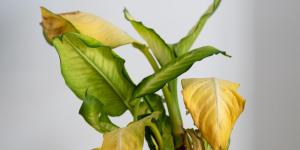What Causes the Leaves of My Plants to Wrinkle?


As every plant lover knows, plants can talk. It is important to observe them, because they show whether they are healthy and developing well or, on the contrary, if there is something wrong with them. There are a number of factors that can cause a plant's leaves to wrinkle, curl up and turn yellow.
In this oneHOWTO article, we explain why plant leaves become wrinkled and what you can do to fix it.
Lack of water
The first thing you should do when you see a plant with wrinkled leaves is to ask yourself if you have watered it enough. The same goes for some vegetables you have planted in a garden, and even fruit trees. A first external symptom of drought can be wrinkled leaves, and in this case the solution is simple: just increase the frequency of watering.
It is useful to know that the water needs of a plant vary depending on the species, so it is useful to analyze each case, as well as the external conditions. It is especially dangerous for your plants in the transition period from winter to spring, when their leaves tend to wrinkle. This means that temperatures have increased compared to previous months, and therefore the plants need more water.
A dry environment
Poor watering is not always the cause of wrinkled leaves. Lack of humidity is another common factor. Check to see if your plant with wrinkled leaves is near a radiator. Perhaps the heat from the heater is negatively affecting your plant and causing its leaves to dry out. You can move the plant to another location or place a humidifier in the area where you have your plants. This will counteract the effects of a dry environment caused by the air conditioner or heater.
Lack of humidity affects indoor plants the most, keep reading this article to learn more tips on how to take better care of your indoors plants.

Unsuitable products such as fertilizers or pesticides
The root system of the plant absorbs any added nutrient, whether it is added directly to the substrate or through irrigation. Fertilizers or pesticides are an excellent ally for the health of your plants, but they must be used as needed and always take into account the characteristics of the individual plants. Ask yourself if you have recently used a product and the leaves have since become prone to wrinkling. Read the instructions carefully and temporarily suspend its use as a precaution, as it may not be beneficial to your plants.
You can learn to make your own natural fertilizer at home by reading this article on natural fertilizers.
Pests
Fungi, insects, and especially tiny parasites can cause wrinkled leaves. Aphids, red spider mites and white mites feed by sucking water and nutrients from leaves. Look not only for wrinkled leaves, but also for color changes, tiny spots or parasites on the leaves. If this is the case, your plant may need to be treated with an insecticide that will quickly eliminate the pest and return the leaves to normal.
If you think your plants might be being affected by pests, then keep reading this article on how to get rid of pests naturally.

Poor or inadequate substrate
You must also keep in mind that plants cannot grow in any soil. The minerals in the soil as well as its acidity or alkalinity affect its growth. A plant needs elements such as calcium, magnesium and nitrogen to a greater or lesser extent to develop or thrive. If you have not replaced the substrate, it may have gone bad over time and not provide the plants with the nutrients they need. This is especially true for large plants that have been in the same pot for years. If this is the case, a compost or soil change will provide your plant with the energy it needs to regain its normal texture.
Also check the pH of the soil, as it may not be appropriate depending on your plant's needs. Some species, such as hydrangeas, may develop wrinkled leaves if their soil is too alkaline. In these cases, you will need to use an acidifying fertilizer to maintain the appropriate pH.
Mold
White mold, sometimes seen in the first layer of soil in a pot, does not cause wrinkling on the leaves, but is an indication that the plant is watered too much or the substrate is not adequately aerated. In such cases, remove the mold layer and a good portion of the soil it is in. Use a small garden spade to remove all the substrate without damaging the roots! Replace the substrate with new soil and stop watering for two or three days. In addition, you can apply a fungicide to ensure that the mold is eradicated.
If you want to learn more about how to rid your plants of white mold, then continue reading this article on white mold on plants.
Irrigation method
The amount of water you pour on a plant each time you water it is as important as the method you use to do it. Dousing some plants directly with water can cause the leaves to become damaged or wrinkled. Plants with large leaves, such as orchids and begonias, do not benefit as much from a large amount of water poured directly on them, and prefer a gentle spray once a week.
If you want to read similar articles to What Causes the Leaves of My Plants to Wrinkle?, we recommend you visit our Gardening & plants category.






